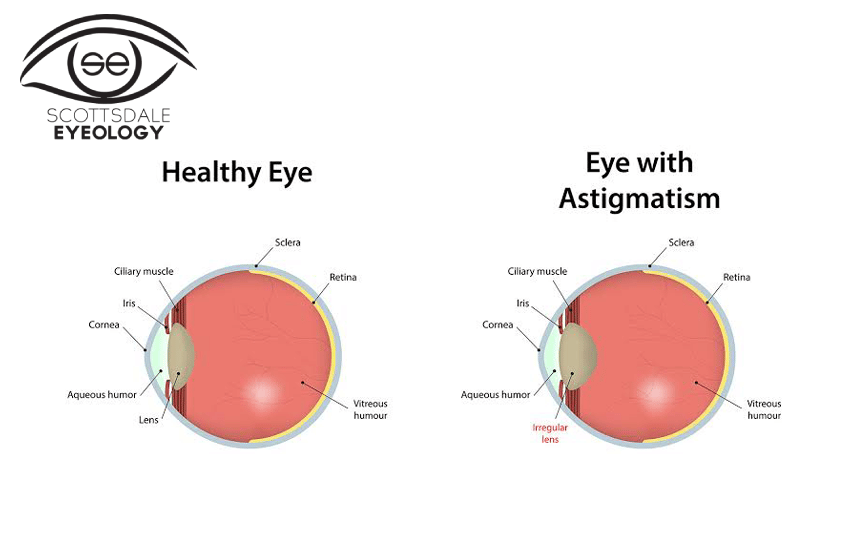Browse Eyewear

A refractive error called astigmatism happens when the cornea or lens that helps the eye focus and see isn’t as smooth or round as it should be. Astigmatism is a type of refractive error. This makes the light that comes into the eye scatter and focus on different parts of the retina simultaneously. There are two types of refractive errors: myopia (near-sightedness) and hypermetropia (far-sightedness). Astigmatism makes vision blurry and distorted, and it can happen on its own or with other refractive errors (far-sightedness). Visit our Scottsdale AZ care for Astigmatism treatment.
It is possible to have different types of astigmatism
Astigmatism can be of two types: corneal and lenticular. When the cornea hasn’t been shaped the way it should be, it’s called corneal astigmatism (when the lens is irregularly shaped).
When you look at your eye, the cornea has two axes. Astigmatism is when one axis is steeper, and the other is flat. The difference between the steeper and the flatter axis is used to determine how much astigmatism there is in the eye.
Regular astigmatism and irregular astigmatism are two more types of corneal astigmatism. There are two axes of the eye 90 degrees apart from each other. Irregular astigmatism is when the eye’s curvature isn’t the same across the cornea, which makes it hard for us to see.
Astigmatism is caused by what?
There are many different types of astigmatism, and it can happen because of genetics and other things, like an irregular shape of the eye’s cornea or lens or because of corneal diseases.
The shape of the cornea or lens
Astigmatism occurs when light bends differently depending on where it meets the cornea, the lens, and how it travels through it. All of the parts of the cornea or lens in an eye with no astigmatism, like a football, are the same size and shape. This is how the cornea or lens looks in an eye with astigmatism. Some parts are steeper or more rounded than others.
Genetics
Astigmatism people have three significant genes that work together to make it happen, but the same gene hasn’t been found yet. It was found that children with one parent or a sibling with astigmatism have a close to 50% higher chance of getting the condition themselves.
These are babies born too soon
A study looked at the refractive errors (myopia, hypermetropia, astigmatism) in premature babies born before 32 weeks of pregnancy. It found that 2 in 10 premature babies had astigmatism. This could be because the cornea didn’t have enough time to grow properly while it was in the womb. There may also be structural problems with the cornea that causes astigmatism.
Other eye diseases are also out there
It’s called Keratoconus, and it’s a disease of the eye that makes the cornea thin and changes shape. This can cause astigmatism that isn’t straight. Keratoconus affects 1 in 2000 people in the U.S. It was found that 1 in 10 people who have Keratoconus have a parent who has it, too.
Someone rubs their eyes
Infections or vision changes can happen. You might need to see a doctor. Some people who have allergies have itchy eyes, making them want to rub their eyes. It could also be a reflex or a habit to rub your eyes when you’re stressed or tired. Rubbing the eyes hard enough to make them lose their round shape can hurt the eyes over time, and it has been linked to the development of astigmatism in some people.
How do you know if you have astigmatism?
There are many signs and symptoms of Astigmatism:
- The vision that is blurry or distorted when you look at both near and far objects
- Squinting as you try to focus on both near and far objects
- Have trouble with your eyes
- Headaches
- At night, it’s hard to see well, especially when you’re driving.
Astigmatism is treated in this way:
People who have astigmatism can’t get rid of it, though. When high astigmatism (more than 4.00D) in children goes uncorrected, the eye may be ignored by the brain because it doesn’t get enough information from the brain.
Astigmatism can be fixed by using glasses, contact lenses, or surgery to improve vision. An eye doctor in Scottsdale, AZ, will help you choose the best option based on your age, the amount of astigmatism, the health of your eye, and your vision needs.
Spectacles
People with astigmatism can use glasses to help them see better. Glasses may be needed all the time or only when doing things that need a clear vision, like driving or reading. Prescription glasses that help correct the problem have a unique cylindrical lens prescription that gives the correct lens power to fix the problem.
Contact Lenses
Contact lenses come in two main types: soft and hard. Most people choose soft contacts, which are more flexible and can fit their eyes. In eyes with irregular astigmatism, an eye doctor may recommend hard contact lenses. Because the lenses are complex, they make the eye’s surface more even, which improves how light enters and interacts with the eye and allows for clear vision.
Visit Scottsdale AZ Eye Care for Astigmatism treatment in Arizona.



